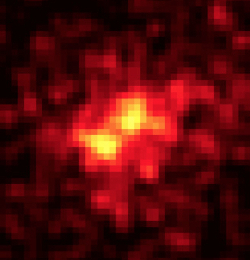 HEAPOW: GR Pulsar Beyond the Milky Way (2015 Nov 16)
HEAPOW: GR Pulsar Beyond the Milky Way (2015 Nov 16)
The Gamma-ray sky is mysterious. It's dominated by very high energy emission from extreme, incredibly dense objects like black holes and neutron stars. Groups of normal young stars have also been associated with Gamma-ray emission. A particularly interesting region is the Tarantula Nebula in the Large Magellanic Cloud, the largest, most active star forming region in our galactic neighborhood, and a strong source of Gamma-ray emission. This emission could arise from strong shocks produced by massive stellar winds from and explosions of the extremely bright young stars in the nebula. Astronomers think that these shocks could accelerate charged particles (electrons, protons, and other atomic nuclei) to very high energies, and these so-called cosmic rays could generate the observed Gamma-ray emission from the Tarantula. But a new study by the Large Area Telescope (LAT) on the Fermi Gamma-ray Space Telescope has turned this idea on its head. Using data accumulated by the LAT over the past 6 years, and using an improved data processing, astronomers have resolved the emission from the Tarantula Nebula into two discrete sources, as shown in the LAT image above. These sources, shown as bright yellow points in the false-color Gamma-ray image, are both associated with X-ray pulsars, rapidly spinning, high-energy neutron stars which produce periodic flashes of X-rays. The source near the bottom of the image is near a previously identified X-ray pulsar in the Large Magellanic Cloud known as PSR J0540-6919. The Fermi observations show that the Gamma-ray emission pulses with the X-ray period, confirming the pulsar as the Gamma-ray source. This new analysis shows that this single pulsar is responsible for roughly half of the gamma-ray emission that was originally thought to come from the entire Tarantula Nebula, and makes this the first Gamma-ray pulsar to be detected in another galaxy.
GSFC: Fermi Detects First Gamma-ray Pulsar in Another Galaxy
http://asterisk.apod.com/viewtopic.php?t=35361
| << Previous HEAPOW | High Energy Astrophysics Picture of the Week | Next HEAPOW >> |